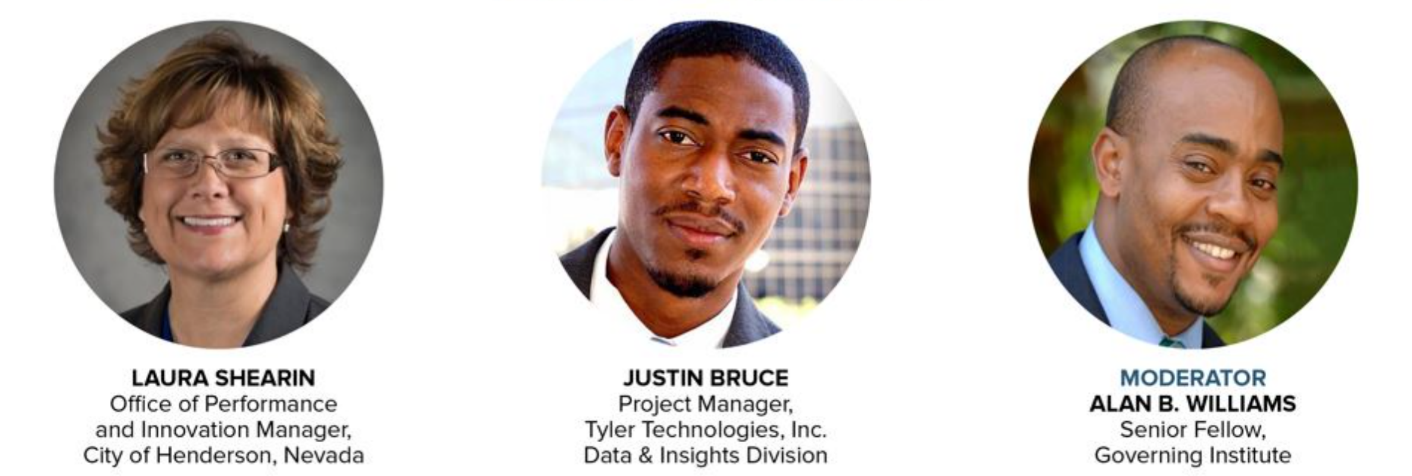Top Three Ways to Revolutionize Internal Data Sharing
March 18, 2019 by Meredith Trimble

Many of the challenges local governments face today can be effectively addressed with data. The Mayor of Henderson, Nevada, in recognizing this, has been known to give out plaques stating, “If you don’t have data, you’re just another person with an opinion.” He’s on to something! Data plays a crucial role in addressing some of government’s – and society’s – biggest issues. But sharing the right data across departments continues to be a challenge for most agencies.
From the opioid crisis to homelessness to traffic and health care, local governments are without question best poised to create and deliver answers. Internal government staff collect what can seem like endless amounts of data, but how can we connect that information across departments and use it to surface the practical solutions our communities need?
Tyler Technologies joined with Governing for an insightful webinar that followed Henderson’s data-sharing journey. Presenters addressed ways that any size government can effectively share data to maximize operational efficiencies and improve communities. In Connecting Your Government to Data: How to Revolutionize Internal Data Sharing, speakers Laura Shearin, Office of Performance and Innovation Manager, City of Henderson, and Justin Bruce, Project Manager, Tyler Technologies, Data & Insights Division, highlighted three key themes.

1. Tie data to performance.
In Henderson, the driving force behind data use was to give high-performing teams the tools they needed to be able to advance and make an impact. Data sharing began with a simple framework that integrated departments organization-wide with goals that aligned to one strategic vision. Department heads chose the high-level performance metrics that mattered most to them and thought through how, exactly, they wanted to measure success. Now, department progress is not just measured but shared across the organization, and data tools enable leaders to hold themselves accountable and be transparent internally as well as to residents.
The value in performance management is getting everyone to look at data and make data-driven decisions. An intangible benefit is that data can take emotion out of decisions and make tough conversations easier. Moving from silos to sharing can come with a learning curve, as organizations decide which data to share, how it will be analyzed, and specifically how it can move teams forward. The bottom line is to ensure that better-informed decisions – from budgeting to resource allocation – will help staff better address community concerns and desires. Data moves average KPIs into something much more robust. When you measure, share, and collectively act on what you’re measuring, you can move forward such that teams can segregate dollars saved through efficiencies and visibly reallocate them in alignment with the organization’s broad vision.
2. Foster inter-agency collaboration.
One of Shearin’s main goals in Henderson was to “use data to collaboratively work together to solve problems in the community.” She facilitates regular data discussions in which every department shares its KPIs in a comfortable, open forum. These sessions highlight not just successes but facilitate brainstorming around real challenges. Technology and a centralized database are key to these meetings, as modern dashboards with accessible visualizations give everyone a way to quickly see, understand, and discuss information. Shearin also created a physical collaborative space in which people can connect in person, in a central location, to brainstorm and innovate.
3. Change your organizational culture.
Shearin views her biggest data win as the “real, substantial change in culture” in Henderson. Moving from a siloed organization in which people were protective of their information to making decisions in a collaborative way has made lives easier, on the job and in the community.
The city saved millions of dollars, for example, and improved fire department response times by analyzing response time and geographic data and subsequently doing the opposite of what conventional wisdom would suggest. Willingness to view and trust data also streamlined Parks & Rec inspections for better capital allocations. A closer look at safety statistics organization-wide reduced OSHA-reportable injuries.
These early successes are paving the way for tackling even larger issues. Bringing diversity of experience and diversity of data to the table and sharing data across boundaries at a regional level has resulted in new collaborations around homelessness and the opioid crisis. This can happen because all stakeholders, from the ground up, are on board and used to seeing and using data every day.